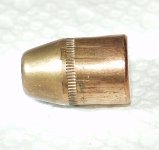"Conventional Wisdom" is that you should not load 110/296 less than 10% below maximum or less than 90% of case capacity.
This has never been formalized to my knowledge and is a consensus developed over the years.
Read enough loading manuals and you will get the idea

Heck, I have even seen some recipes using it in the 44 Special, something I myself would not attempt.
Plenty better powders.
Like the above, I have stuck a bullet but never seen over pressure I could detect.
I am moving away from using this powder completely in fact.
4227 will do most everything 296 will if you are willing to give up a few fps and do it with more grace.
This bullet went half-way into the forcing cone of my Redhawk and stopped.
It was a full load of W296 with a WLP primer.
Still not sure what happened as the rest of the box worked fine.
Luckily I figured it out before dropping the hammer again.
Bad mojo.
Still get the sweats thinking about what could have been.
Another thing to keep in mind is that the Winchester advice was published early on and a lot more independent
testing has been done since then by Hodgdon and the bullet makers.
In fact W296 is an improved version of W295 which was even MORE finicky to the point it was withdrawn from the market.
I feel the original wording has a good portion of butt covering behind it.
===
Nemo

